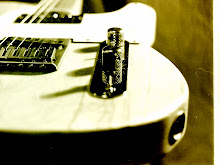
I have a new guitar hero. After seeing Bill Frisell at the Narrows Center for the Arts in Fall River last night, I’m totally smitten with the jazzy maestro’s understated, soul-stirring guitar mastery.
I’m not really a jazz guy. As much as I confidently claim rock and blues aficionado cred, I make no such pretense in the jazz realm. My jazz likes are sporadic and idiosyncratic. And, though Frisell is generally considered to be a jazz guitarist, I don’t think that really captures the essence of his playing. Sure there are moments of straight jazz modal playing, bebop-ish jaunts, precise arrangements and remarkably synchronized interplay with his fellow musicians. And, very occasionally, there’s even a lickety-split, jazzy lead guitar run. But, for the most part, what Frisell plays seems to me to be something else – something different, otherworldly. Cosmic, country, folk, surf, rockabilly with jazz tinges.
Suffice to say, an open-minded guitar player in the 21st century can’t help but channel the panoply of musical influences in the air for the last half-century or so. And Frisell is no exception – except that he renders the alchemical amalgamation of styles and influences so extraordinarily and with such exquisite taste. He’s an unpretentious sonic architect who sure knows how to pluck those strings!
Frisell refrains from the guitar histrionics of flashy, semi-spastic, fingers flying, single-note guitar leads and riffs – standard fare for our favorite rock guitar slingers (as well as amateur hackers like me!). He plays mostly understated arpeggios, yet still drives his bandmates and provides compelling listening. And, in his concentrated but unassuming way, he makes it look effortless.
In the past, Frisell’s repertoire has featured emotive, slow-building, cyclical takes on “I Heard It Through the Grapevine,” “A Hard Rain’s A-Gonna Fall” and”Shenandoah,” often laced with wild, swirling sonic effects suggestive of some of Robert Fripp, Adrian Belew or Arto Lindsay’s guitar palettes. The effects were much less in evidence last night.
Perhaps this is because the current lineup of Frisell’s trio affords ample opportunity for melodic interaction and invention. Comprising drummer Rudy Royston and violinist Eyvind Kang (needless to say, both exceptional musicians), the trio delivered controlled combustion and flights of sonic fancy.
At times it was even evocative of jazz greats Django Reinhardt and Stephane Grappelli’s fantastic interplay in France in the 1930s and 1940s – not so much in the specific sound or style, but in the feel of the tandem guitar-violin dialog.
Most of the songs start out quiet, jazzy and/or understated and build momentum and urgency, ultimately to climax as something else. Along the way, a broad smile inevitably traverses the guitarist’s face as he locks in with his fellow musicians.
I have to admit, for me to enjoy a 90-plus minutes of purely instrumental music and only be able to identify one of the tunes by name (the old folk standard “Sunnyside of the Street”), the musicians have to deliver quite a compelling performance … and they certainly did! In fact, it was sublime.

This was the second time I’ve seen Frisell, now 59, perform with his trio. The first time was in 2005 at a small jazz club in Cambridge. We were so close to the stage, that we literally had to worry about him knocking our drinks off the table with headstock of his guitar when he turned to cast a glance at his musical compadres. (Charlie Watts was in the audience that night as the Stones were in the midst of their three-night run at Fenway Park). That night, Frisell had a more traditional jazz trio line-up of upright bass and drums (very loud drums from our vantage point). He also relied heavily on his many effects to add to the sonic swirl and avant garde flavorings.
Yet, despite how much I enjoyed, that evening’s listening five years ago, I wasn’t expecting what I heard last night. If I had known that it was going to be as good as it was, I would’ve twisted every friendly arm within 50 miles join me.
Final Note: Narrow Name, Broad Appeal
I’ve seen a dozen or more shows at The Narrows Center for the Arts over the last five or six years and it has to be one of eastern Massachusetts’ best-kept secrets. In the forgotten city of Fall River (straddling the R.I./Mass. border), in the shadow of a vintage World War II battleship tourist attraction, sits this old three-story brick warehouse, the top floor of which has been transformed in an art gallery, working artists’ studios and an open, informal and welcoming performance space. Run by volunteers, tickets are reasonably priced and the bring-your-own beverage policy and reclaimed church pews seating make for a welcoming, low-key venue. And, while the feel is coffeehouse-like, I’ve seen some fiery, inspired performances there (Graham Parker, The Mekons, et al).
Further
• The brief Bill Frisell biography on his official website paints a vivid picture of the breadth of his work and the esteem in which he is held in musical circles.





No comments:
Post a Comment